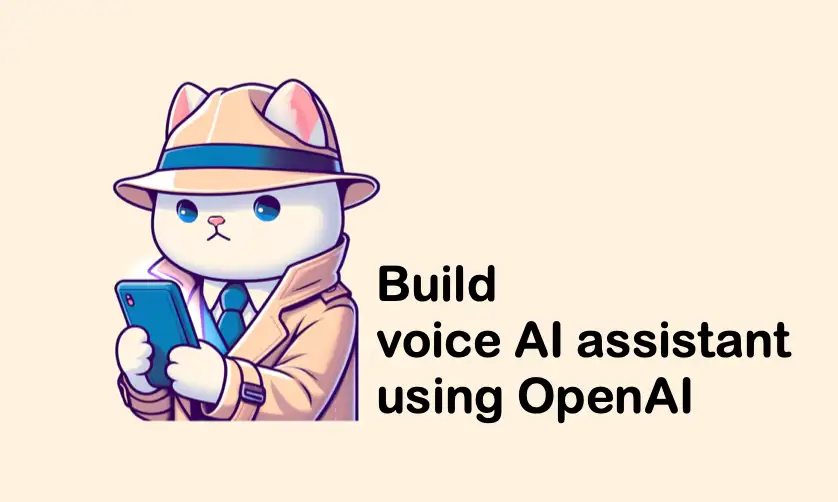Build Voice Assistants Easily With OpenAI's New Tools

Table of Contents
Understanding OpenAI's Relevant Tools for Voice Assistant Development
OpenAI offers a suite of powerful APIs specifically designed to streamline the voice assistant development process. These APIs handle the complex tasks of speech processing and natural language understanding, allowing you to focus on the core logic and user experience of your assistant.
Leveraging OpenAI's APIs for Speech-to-Text and Text-to-Speech Conversion
Accurate and efficient speech-to-text and text-to-speech conversion are fundamental to any voice assistant. OpenAI provides exceptional tools for both:
-
Whisper API: This API offers state-of-the-art speech-to-text capabilities, supporting numerous languages and exhibiting remarkable robustness against background noise and accents. Its accuracy and efficiency make it ideal for building reliable voice assistants. It's incredibly versatile, handling various audio formats with ease.
-
OpenAI's Text-to-Speech API: This API generates natural-sounding speech from text, offering a range of customization options, including different voices, speeds, and intonations. This allows you to tailor the voice of your assistant to perfectly match your application's needs and brand identity.
Here's a basic Python example demonstrating the use of both APIs:
# Install necessary libraries: pip install openai
import openai
# Set your OpenAI API key
openai.api_key = "YOUR_API_KEY"
# Speech-to-text using Whisper
transcript = openai.Audio.transcribe("whisper-1", open("audio.mp3", "rb"))
print(f"Transcription: {transcript['text']}")
# Text-to-speech
response = openai.Audio.translate("This is a test.", model="tts-1")
with open("output.mp3", "wb") as f:
f.write(response.to_bytes())
Remember to replace "YOUR_API_KEY" with your actual API key and provide an audio file named audio.mp3.
Utilizing OpenAI's Language Models for Natural Language Understanding (NLU)
Natural Language Understanding (NLU) is the heart of any intelligent voice assistant. OpenAI's powerful language models, such as GPT models, excel at understanding user intent and extracting key information from voice commands.
-
Intent Recognition: GPT models can be fine-tuned to recognize specific user intentions, allowing your assistant to respond appropriately to various commands and requests.
-
Information Extraction: These models can extract crucial data from user utterances, like dates, locations, or specific items mentioned.
-
Prompt Engineering: Crafting effective prompts is essential for optimal NLU performance. For example, instead of a simple "What's the weather?", a more structured prompt like "What is the current temperature and weather conditions in London?" will yield more precise results.
By combining the speech APIs with a language model, you create a complete voice interaction loop: speech is converted to text, the language model processes the text to understand the intent, and the appropriate response is generated and converted back to speech. Fine-tuning these models on your specific use case dramatically improves performance and accuracy.
Step-by-Step Guide to Building a Simple Voice Assistant
This section details building a basic voice assistant using OpenAI's tools.
Setting up the Development Environment
- Install Python: Ensure you have Python 3 installed on your system.
- Install the OpenAI library: Use
pip install openaito install the necessary library. - Obtain an OpenAI API key: Create an account on OpenAI's website and obtain your API key.
- Set up your audio input: You'll need a method for capturing audio input, which can range from a simple microphone to more advanced audio capture libraries.
Coding the Core Functionality
The core functionality involves a loop that captures audio, transcribes it using the Whisper API, processes the text using a GPT model, formulates a response, and converts the response to speech using the text-to-speech API. Code examples will vary based on the chosen libraries for audio input and output.
Testing and Deployment
Testing is crucial. Develop a range of test cases, including various accents, background noises, and different phrasing of commands. Debugging will often involve analyzing the transcription and the model's interpretation of the user's intent. Deployment can be local (running on your own machine) or on a cloud platform for wider accessibility.
Advanced Features and Customization for your Voice Assistant
Once you have a basic voice assistant working, you can expand its capabilities with advanced features:
Integrating with External Services
Connect your assistant to external APIs like weather services, calendar APIs, or music streaming platforms to greatly enhance its functionality. For example, integrate with a weather API to provide real-time weather updates based on user location.
Personalization and User Profiles
Implement user profiles to store preferences and personalize the assistant's responses. This could involve remembering user names, locations, or preferred settings.
Improving Accuracy and Handling Errors
Continuously monitor and improve the accuracy of your assistant. Implement robust error handling to provide informative feedback to users when the assistant fails to understand a command or encounters unexpected issues.
Conclusion: Unlock the Power of Voice Assistants with OpenAI
Building voice assistants has become significantly more accessible thanks to OpenAI's powerful and user-friendly tools. By combining the Whisper API, text-to-speech API, and OpenAI's language models, you can create sophisticated voice assistants with minimal effort. Remember the key steps: setting up your environment, coding the core functionality using the APIs, thorough testing, and finally, expanding with advanced features and personalization. Start building your own voice assistant today! Explore OpenAI's powerful tools for voice assistant development and learn more about creating innovative voice applications with OpenAI. Visit the OpenAI documentation for more detailed information and examples.

Featured Posts
-
 Plan Your Monday Night Top 10 Tv And Streaming Picks
May 26, 2025
Plan Your Monday Night Top 10 Tv And Streaming Picks
May 26, 2025 -
 Tadej Pogacars Tour Of Flanders Strava Data No Flag This Year
May 26, 2025
Tadej Pogacars Tour Of Flanders Strava Data No Flag This Year
May 26, 2025 -
 Addressing Oem Concerns Sg Wireless Expands Manufacturing Partnerships
May 26, 2025
Addressing Oem Concerns Sg Wireless Expands Manufacturing Partnerships
May 26, 2025 -
 Is Canada Posts Decline Creating Opportunities For Competitors
May 26, 2025
Is Canada Posts Decline Creating Opportunities For Competitors
May 26, 2025 -
 Klasemen Moto Gp Jadwal Balapan Silverstone And Pembaruan Terbaru
May 26, 2025
Klasemen Moto Gp Jadwal Balapan Silverstone And Pembaruan Terbaru
May 26, 2025
